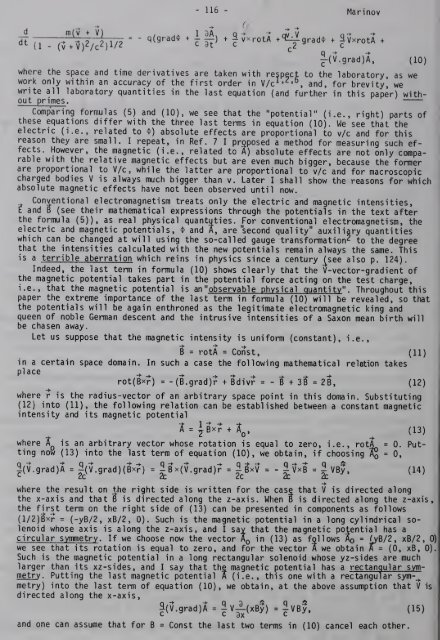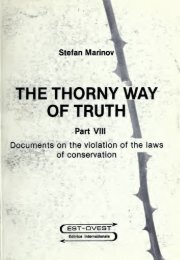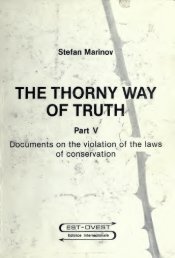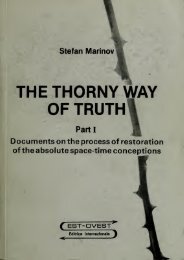The thorny way of truth - Free Energy Community
The thorny way of truth - Free Energy Community
The thorny way of truth - Free Energy Community
You also want an ePaper? Increase the reach of your titles
YUMPU automatically turns print PDFs into web optimized ePapers that Google loves.
" 116 - Marinov<br />
3-(V.grad)A, (10)<br />
where the space and time derivatives are taken with respect to the laboratory, as we<br />
work only within an accuracy <strong>of</strong> the first order in \//c^'^'°, and, for brevity, we<br />
write all laboratory quantities in the last equation (and further in this paper) without<br />
primes .<br />
Comparing formulas (5) and (10), we see that the "potential" (i.e., right) parts <strong>of</strong><br />
these equations differ with the three last terms in equation (10). We see that the<br />
electric (i.e., related to *) absolute effects are proportional to v/c and for this<br />
reason they are small. I repeat, in Ref. 7 I proposed a method for measuring such effects.<br />
However, the magnetic (i.e., related to A) absolute effects are not only comparable<br />
with the relative magnetic effects but are even much bigger, because the former<br />
are proportional to V/c, while the latter are proportional to v/c and for macroscopic<br />
charged bodies V is al<strong>way</strong>s much bigger than v. Later I shall show the reasons for which<br />
absolute magnetic effects have not been observed until now.<br />
Conventional electromagnetism treats only the electric and magnetic intensities,<br />
t and B (see their mathematical expressions through the potentials in the text after<br />
the formula (5)), as real physical quantuties. For conventional electromagnetism, the<br />
electric and magnetic potentials, and A, are "second quality" auxiliary quantities<br />
which can be changed at will using the so-called gauge transformation^ to the degree<br />
that the intensities calculated with the new potentials remain al<strong>way</strong>s the same. This<br />
is a terrible aberration which reins in physics since a century (see also p. 124).<br />
Indeed, the last term in formula (10) shows clearly that the V-vector-gradient <strong>of</strong><br />
the magnetic potential takes part in the potential force acting on the test charge,<br />
i.e., that the magnetic potential is an observable physical quantity ". Throughout this<br />
paper the extreme importance <strong>of</strong> the last term in formula (10) will be revealed, so that<br />
the potentials will be again enthroned as the legitimate electromagnetic king and<br />
queen <strong>of</strong> noble German descent and the intrusive intensities <strong>of</strong> a Saxon mean birth will<br />
be chasen a<strong>way</strong>.<br />
Let us suppose that the magnetic intensity is uniform (constant), i.e.,<br />
B = rotA = Const, (11)<br />
in a certain space domain. In such a case the following mathematical relation takes<br />
place ^ ^ ^ ^ ^ ^ ^<br />
rot(Bxr) = -(B.grad)r + Bdivr = - ^ + 3§ = 2B, (12)<br />
where r is the radius-vector <strong>of</strong> an arbitrary space point in this domain. Substituting<br />
(12) into (11), the following relation can be established between a constant magnetic<br />
intensity and its magnetic potential<br />
^ = ^Bxr + ^Q, (13)<br />
where A is an arbitrary vector whose rotation is equal to zero, i.e., rotA = 0. Putting<br />
now (13) into the last term <strong>of</strong> equation (10), we obtain, if choosing A^ = 0,<br />
^(V.grad)A - |-(V.grad) (Bxr) = ^Bx(V.grad)r =<br />
^ BxV = - ^ VxB = ^<br />
VBy, (14)<br />
-*<br />
where the result on the right side is written for the case that V is directed along<br />
the x-axis and that B is directed along the z-axis. When B is directed along the z-axis<br />
the first term on the right side <strong>of</strong> (13) can be presented in components as follows<br />
(l/2)Bxr = (-yB/2, xB/2, 0). Such is the magnetic potential in a long cylindrical solenoid<br />
whose axis is along the z-axis, and I sav that the magnetic potential has a<br />
circular symmetry . If we choose now the vector Aq i" (13) as follows Aq = ^B/2 , xB/2 , 0)<br />
we see that its rotation is equal to zero, and for the vector A we obtain A = (0, xB, 0),<br />
Such is the magnetic potential in a long rectangular solenoid whose yz-sides are much<br />
larger than its xz-sides, and I say that the magnetic potential has a rectangular sym -<br />
metry . Putting the last magnetic potential A (i.e., this one with a rectangular sym-^<br />
metry) into the last term <strong>of</strong> equation (10), we obtain, at the above assumption that V is<br />
directed along the x-axis,<br />
a(V.grad)A = ^vi-(xBy) =§VBy. (15)<br />
and one can assume that for B = Const the last two terms in (10) cancel each other.








